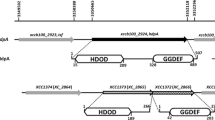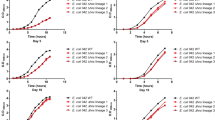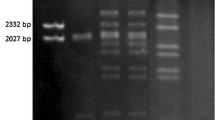Abstract
The small basic histone-like protein H-NS is known for bacteria to attenuate virulence of several animal pathogens. An hns homologue from E. amylovora was identified by complementing an E. coli hns-mutant strain with a cosmid library from E. amylovora. A 1.6 kb EcoRI-fragment complemented the mucoid phenotype and repressed the ß-glucosidase activity of E. coli PD32. The open reading frame encoding an H-NS-like protein of 134 amino acid was later shown to be located on plasmid pEA29 (McGhee and Jones 2000). A chromosomal hns gene was amplified with PCR consensus primers and localized near galU of E. amylovora. E. amylovora mutants were created by insertion of a resistance cassette, and the intact gene was inserted into a high copy number plasmid for constitutive expression. Purified chromosomal H-NS protein preferentially bound to a DNA fragment from the lsc region and bending was predicted for an adjacent fragment with the rlsB-promoter. Levan production was significantly increased by hns mutations. Synthesis of the capsular exopolysaccharide amylovoran and of levan were reduced, when hns from the E. amylovora plasmid was overexpressed. A mutation in chromosomal hns of E. amylovora increased amylovoran synthesis, and both mutations retarded symptom formation on immature pears.






Similar content being viewed by others
References
Afflerbach H, Schroder O, Wagner R (1999) Conformational changes of the upstream DNA mediated by H-NS and FIS regulate E. coli RrnB P1 promoter activity. J Mol Biol 286:339–353
Aldridge PD (1996) The environmental and genetic regulation of virulence mechanisms of Erwinia amylovora. Thesis, University of Leicester
Ali Azam T, Iwata A, Nishimura A, Ueda S, Ishihama A (1999) Growth phase-dependent variation in protein composition of the Escherichia coli nucleoid. J Bacteriol 181:6361–6370
Atlung T, Ingmer H (1997) H-NS: a modulator of environmentally regulated gene expression. Mol Microbiol 24:7–17
Bahloul A, Boubrik F, Rouviere-Yaniv J (2001) Roles of Escherichia coli histone-like protein HU in DNA replication: HU-beta suppresses the thermosensitivity of dnaA46ts. Biochimie 83:219–229
Barny MA, Guinebretiere MH, Marcais B, Coissac E, Paulin JP, Laurent J (1990) Cloning of a large gene cluster involved in Erwinia amylovora CFBP1430 virulence. Mol Microbiol 4:777–786
Bellemann P, Bereswill S, Berger S, Geider K (1994) Visualisation of capsule formation by Erwinia amylovora and assays to determine amylovoran synthesis. Internat J Biol Macromol 16:290–296
Beloin C, Deighan P, Doyle M, Dorman CJ (2003) Shigella flexneri 2a strain 2457T expresses three embers of the H-NS-like protein familiy: characterization of the Shf protein. Mol Gen Genomics 270:66–77
Bereswill S, Geider K (1997) Characteristion of the rcsB gene from Erwinia amylovora and its influence on exopolysaccharide synthesis and virulence of the fire blight pathogen. J Bacteriol 179:1354–1361
Bereswill S, Pahl A, Bellemann P, Zeller W, Geider K (1992) Sensitive and species-specific detection of Erwinia amylovora by polymerase chain reaction analysis. Appl Environ Microbiol 58:3522–3526
Bernhard F, Poetter K, Geider K, Coplin DL (1990) The rcsA gene from Erwinia amylovora: identification, nucleotide sequence and regulation of exopolysaccharide biosynthesis. Mol Plant Microbe Interact 3:429–437
Bertin P, Terao E, Lee EH, Lejeune P, Colson C, Danchin A, Collatz E (1994) The H-NS protein is involved in the biogenesis of flagella in Escherichia coli. J Bacteriol 176:5537–5540
Bogs J, Bruchmüller I, Erbar C, Geider K (1998) Colonization of host plants by the fire blight pathogen Erwinia amylovora marked with genes for bioluminescence and fluorescence. Phytopathology 88:416–421
Brunetti R, Prosseda G, Beghetto E, Colonna B, Micheli G (2001) The looped domain organization of the nucleoid in histone-like protein defective Escherichia coli strains. Biochimie 83:873–882
Bugert P, Geider K (1995) Molecular analysis of the ams operon required for exopolysaccharide synthesis of Erwinia amylovora. Mol Microbiol 15:917–933
Claret L, Rouviére-Yaniv (1997) Variation in HU composition during growth of Escherichia coli: the heteroduplex is required for long term survival. J Mol Biol 273:93–104
Csonka LN, Hanson AD (1991) Prokaryotic osmoregulation: genetics and physiology. Annu Rev Microbiol 45:569–606
Dame RT, Wyman C, Wurm R, Wagner R, Goosen N (2002) Structural basis for H-NS-mediated trapping of RNA polymerase in the open initiation complex at the rrnB P1. J Biol Chem 277:2146–2150
Dame RT, Goosen N (2002) HU: promoting or counteracting DNA compaction? FEBS Lett 529:151–156
Dersch P, Schmidt K, Bremer E (1993) Synthesis of the Escherichia coli K-12 nucleoid-associated DNA-binding protein H-NS is subjected to growth-phase control and autoregulation. Mol Microbiol 8:875–889
Dole S, Nagarajavel V, Schnetz K (2004) The histone-like nucleoid structuring protein H-NS represses the Escherichia coli bgl operon downstream of the promoter. Mol Microbiol 52:589–600
Dorman CJ (2004) H-NS: a universal regulator for a dynamic genome. Nat Rev Microbiol 2:391–400
Dorman CJ, Deighan P (2003) Regulation of gene expression by histone-like proteins in bacteria. Curr Opin Genet Dev 13:179–184
Dorman CJ, Hinton JCD, Free A (1999) Domain organization and oligomerization among H-NS-like nucleoid-associated proteins in bacteria. Trends Microbiol 7:124–128
Du Z, Geider K (2002) Characterization of an activator gene upstream of lsc, involved in levan synthesis of Erwinia amylovora. Physiol Mol Plant Pathol 60:9–17
Eastgate JA, Taylor N, Coleman MJ, Healy B, Thompson L, Roberts IS (1995) Cloning, expression and characterisation of the lon gene of Erwinia amylovora: Evidence for a heat-shock response. J Bacteriol 177:932–937
Falkenstein H, Bellemann P, Walter S, Zeller W, Geider K (1988) Identification of the fire blight pathogen Erwinia amylovora, by colony hybridization with DNA from plasmid pEA29. Appl Environ Microbiol 54:2798–2802
Falkenstein H, Zeller W, Geider K (1989) The 29 kb plasmid, common in strains of Erwinia amylovora, modulates development of fire blight symptoms. J Gen Microbiol 135:2643–2650
Geider K, Baldes R, Bellemann P, Metzger M, Schwartz T (1995) Mutual adaptation of bacteriophage fd, pfd plasmids and their host strains. Microbiol Res 150:337–346
Geider K, Hohmeyer C, Haas R, Meyer TF (1985) A plasmid cloning system utilising replication and packaging functions of the filamentous bacteriophage fd. Gene 33:341–349
Geier G, Geider K (1993) Characterization and influence on virulence of the levansucrase gene from the fire blight pathogen Erwinia amylovora. Physiol Mol Plant Pathol 42:387–404
Gottesman S (1995) Regulation of capsule synthesis: modification of the two-component paradigm by an accessory unstable regulator. In: Hoch JA, Silhavy TJ (eds) Two-component signal transduction. ASM Press, Washington, pp 253–262
Higgins CF, Hinton JC, Hulton CS, Owen-Hughes T, Pavitt GD, Seirafi A (1990) Protein H1: a role for chromatin structure in the regulation of bacterial gene expression and virulence? Mol Microbiol 4:2007–2012
Hommais F, Krin E, Laurent-Winter C, Soutourina O, Malpertuy A, Le Caer J P, Danchin A, Bertin P (2001) Large-scale monitoring of pleiotropic regulation of gene expression by the prokaryotic nucleoid-associated protein, H-NS. Mol Microbiol 40:20–36
Jaquet M, Cukier-Kahn R, Pla J, Gros F (1971) A thermostable protein factor acting on in vitro DNA transcription. Biochem Biophys Res Commun 45:1597–1607
Johansson J, Uhlin BE (1999) Differential protease-mediated turnover of H-NS and StpA revealed by a mutation altering protein stability and stationary phase suvival of Escherichia coli. Proc Natl Acad Sci USA 96:10776–10781
Kim JF, Beer SV (2000) hrp genes and harpins of Erwinia amylovora: a decade of discovery. In: Vanneste J (ed) Fire blight: the disease and its causative agent Erwinia amylovora. CABI Publishing, Wallingford, pp 117–140
Lucht JM, Dersch P, Kempf B, Bremer E (1994) Interactions of the nucleoid-associated DNA-binding protein H-NS with the regulatory region of the osmotically controlled proU operon of Escherichia coli. J Biol Chem 269:6578–6578
Maxson-Stein K, McGhee GC, Smith JJ, Jones AL, Sundin GW (2003) Genetic analysis of a pathogenic Erwinia sp. isolated from pear in Japan. Phytopathology 93:1393–1399
McGhee GC, Jones AL (2000) Complete nucleotide sequence of ubiquitous plasmid pEA29 from Erwinia amylovora strain Ea88: Gene organization and intraspecies variation. Appl Environ Microbiol 66:4897–4907
Mojica FJ, Higgins CF (1997) In vivo supercoiling of plasmid and chromosomal DNA in an Escherichia coli hns mutant. J Bacteriol 179:3528–3533
Owen-Hughes TA, Pavitt GD, Santos DS, Sidebotham JM, Hulton CS, Hinton JC, Higgins CF (1992) The chromatin-associated protein H-NS interacts with curved DNA to influence DNA topology and gene expression. Cell 71:255–265
Rimsky S, Zuber F, Buckle M, Buc H (2001) A molecular mechanism for the repression of transcription by the H-NS protein. Mol Microbiol 42:1311–1323
Sambrook J, Rusell W (2001) Molecular cloning: a laboratory manual, 3rd edn. Cold Spring Harbor Laboratory Press, Cold Spring Harbor
Shpigelman ES, Trifonov EN, Bolshoy A (1993) Curvature—software for the analysis of curved DNA. Comput Appl Biosci 9:435–440
Sonnenfield JM, Burns CM, Higgins CF, Hinton JCD (2001) The nucleoid-assiciated protein StpA binds curved DNA, has a greater DNA-binding affinity than H-NS and is present in significant levels in hns mutants. Biochimie 83:243–249
Spratt BG, Hedge PJ, te Heesen S, Edelman A, Broome-Smith JK (1986) Kanamycin-resistant vectors that are analogues of plasmids pUC8, pUC9, pEMBL8 and pEMBL9. Gene 41:337–342
Tupper AE, Owen-Hughes TA, Ussery DW, Santos DS, Ferguson DJ, Sidebotham J, Hinton JC, Higgins CF (1994) The chromatin-associated protein H-NS alters DNA topology in vitro. EMBO J 13:258–268
Vanneste JL (2000) Fire blight: the disease and its causative agent Erwinia amylovora. CABI Publishing, Wallingford
Varshavsky AJ, Nedospasov SA, Bakayev VV, Bakayeva TG, Georgiev GP (1977) Histone-like proteins in the purified Escherichia coli deoxyribonucleoprotein. Nucleic Acids Res 4:2725–2745
Wang RF, Kushner SR (1991) Construction of versatile low-copy-number vectors for cloning, sequencing and gene expression in Escherichia coli. Gene 100:195–199
Wei ZM, Sneath BJ, Beer SV (1992) Expression of Erwinia amylovora hrp genes in response to environmental stimuli. J Bacteriol 174:1875–1882
Westermark M, Oscarsson J, Mizunoe Y, Urbonaviciene J, Uhlin BE (2000) Silencing and activation of ClyA cytotoxin expression in Escherichia coli. J Bacteriol 182:6347–6357
Yang J, Tauschek M, Strugnell R, Robins-Browne RM (2005) The H-NS protein represses transcription of the eltAB operon, which encodes heat-labile enterotoxin in enterotoxigenic Escherichia coli, by binding to regions downstream of the promoter. Microbiology 151:1199–1208
Acknowledgements
We thank S. Jock for a series of experiments to cure cells from pEA29 and B. Schneider for comments on the manuscript.
Author information
Authors and Affiliations
Corresponding author
Additional information
Communicated by A. Kondorosi
Rights and permissions
About this article
Cite this article
Hildebrand, M., Aldridge, P. & Geider, K. Characterization of hns genes from Erwinia amylovora . Mol Genet Genomics 275, 310–319 (2006). https://doi.org/10.1007/s00438-005-0085-5
Received:
Accepted:
Published:
Issue Date:
DOI: https://doi.org/10.1007/s00438-005-0085-5




